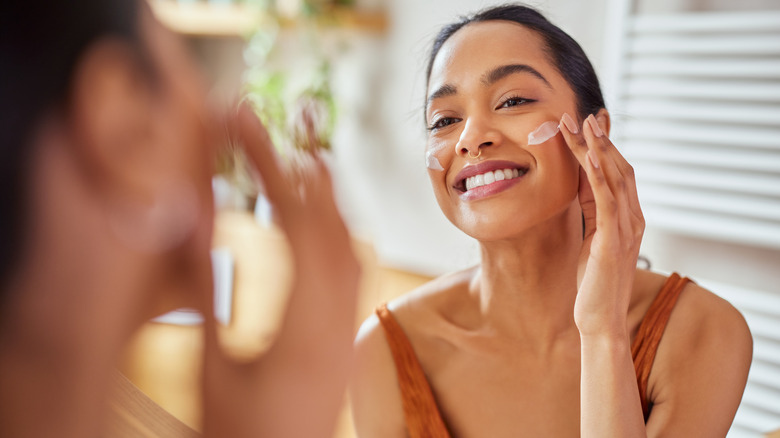Why You Should Never Mix Up The Order Of Your Skincare
We may receive a commission on purchases made from links.
Whether you have a thorough 10-step skincare routine or you keep it simple with just a cleanser and moisturizer, the order in which you apply your products matters. Dermatologists and skincare experts will agree that it's best to apply your products from thinnest to thickest. "In general, think thin-to-thick, but you also want to first use the products with the ingredients that are most important to penetrate into the skin (like antioxidants in serums) and finish with the products that need to sit on top of the skin (like emollients and humectants in moisturizers)," board-certified dermatologist Dr. Heather Rogers told Dermstore.
That being said, cleansing should always be your first step. Next comes toners, serums, and spot treatments which are then followed by heavier moisturizers, eye creams, and sunscreen. It's good to apply skincare products quickly after cleansing, especially hydrating toners or serums that help retain your skin's moisture. While some experts recommend a simple routine with fewer steps, everyone's skin has different needs. If your routine calls for several different products, it's important to make sure you're maximizing their benefits.
The order impacts a product's effectiveness
The order of application is particularly important for toners and serums, as they should be applied after cleansing and never after a moisturizer. A toner removes any excess dirt and oil you may have missed washing your face while also prepping the skin for other products in your routine, like your serums.
Serums are often water-based, so if placed on top of an oil-based moisturizer, your skin will most likely have trouble absorbing the active ingredients in the serum, as oil and water repel each other. If you use more than one serum, there are a few skincare combos that can be layered to work together. For instance, hyaluronic acid and retinol serums often work well together because hyaluronic acid helps hydrate the skin and balance out any dryness that may help with retinol, which is often used as an anti-aging product. Niacinamide and vitamin C are another example, as both work to brighten the skin, with vitamin C's antioxidant properties helping to also protect the skin. Additionally, as board-certified dermatologist Craig Austin suggested to Dermstore, "... you can layer a vitamin C serum for dark spots with a squalene serum for hydration." It's a good idea to use no more than three serums so your skin doesn't become overwhelmed or irritated with an assortment of products.
The wrong order may cause breakouts
Your skincare routine is meant to help you avoid breakouts, not make acne worse. Every skincare product is made to be used in a specific way. For instance, a toner is meant to be absorbed directly into the skin and not on top of a moisturizer. Moisturizer creates a barrier on the skin, so if you apply a toner on top, your skin can't absorb the ingredients of your toner. This can actually make your skin feel more dehydrated, which isn't the goal.
In an interview with Real Simple, board-certified dermatologist Dr. Dendy Engelman explained that the misuse of toners can lead to breakouts. "If the toner used is clarifying or more on the acidic side, there's a risk of it breaking down the products applied beforehand and causing the skin to become further imbalanced because this type of barrier can also trap sebum, dead skin cells and bacteria in the pores, causing acne breakouts and preventing the skin from breathing." Be mindful about the way you use your products, so you can give your skin the proper care it may need.


